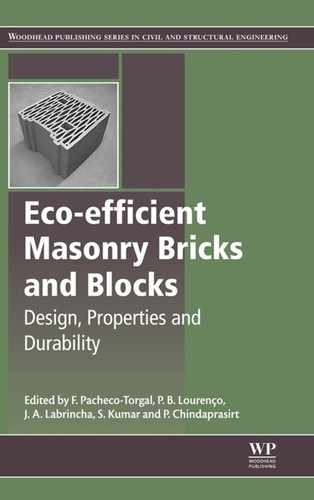The properties and durability of clay fly ash-based fired masonry bricks
Abstract
In the thermal power stations, huge amounts of coal combustion fly ashes are discarded. The fly ashes have very different chemical, mineralogical, and physical compositions, depending on factors such as source and type of coal and the combustion process. They can contain appreciable amounts of highly toxic trace elements. Because of this, the fly ashes are recognized as an environmental pollutant. A significant amount of coal combustion fly ashes produced worldwide is still disposed of in landfills and ash lagoons, costing money and causing environmental impact. Thus, disposal of fly ashes in an environmentally safe manner is a major challenge for thermal power stations using coal as a combustible. The reuse of fly ash as a partial replacement for common clay into fired clay masonry bricks appears to be a viable economic, safe, and sustainable option. This chapter focuses on the reuse of coal combustion fly ash as an alternative raw material to produce clay-based fired masonry bricks. Emphasis is given to the fly ash characteristics and its influence on the physical and mechanical properties. It also covers the durability of the clay-based fired masonry bricks.
Keywords
Clay bricks; Durability; Fly ash; Properties; Reuse5.1. Introduction
5.2. Fly ash characterization
5.2.1. Chemical and mineralogical compositions
Table 5.1
Chemical compositions of several fly ashes
| Oxides | Fly ashes (wt%) | |||||
| European fly ash | Indian fly ash | American fly ash | Brazilian fly ash | Chinese fly ash | Malaysia fly ash | |
| SiO2 | 28.50–59.60 | 45.00–65.25 | 35.00–52.00 | 58.80–71.00 | 56.58 | 56.58 |
| Al2O3 | 17.60–35.60 | 14.00–31.10 | 15.00–32.00 | 19.00–26.30 | 27.83 | 27.83 |
| Fe2O3 | 2.60–16.00 | 3.00–15.00 | 8.00–25.00 | 2.34–8.00 | 4.05 | 4.00 |
| CaO | 0.50–27.30 | 0.10–6.50 | 0.70–8.00 | 0.20–3.78 | 4.31 | 4.30 |
| MgO | 0.60–3.80 | 0.20–3.90 | 0.30–1.50 | 0.20–180 | 1.49 | 1.40 |
| Na2O | 0.10–1.80 | – | – | 0.10–0.70 | – | – |
| K2O | 0.40–4.50 | – | – | 0.40–1.76 | – | – |
| P2O5 | 0.10–1.70 | – | – | 0.04–0.06 | – | – |
| TiO2 | 0.50–2.60 | – | – | 1.18–1.21 | – | – |
| MnO | 0.02–0.10 | – | – | 0.02–0.04 | – | – |
| SO3 | 0.10–8.60 | 0.40–1.80 | 0.10–2.80 | 0.10–0.70 | – | – |
| LOI | 1.10–8.10 | 1.00–11.30 | 1.30–13.00 | 0.20–2.71 | 2.82 | 2.53 |

Sources: Silva et al., 1999; Lingling et al., 2005; Moreno et al., 2005; Sabedot et al., 2011; Shakir et al., 2013.
5.2.2. Physical characterization
5.2.3. Thermal behavior
5.2.4. Environmental characterization
5.3. Fly ash-based fired clay masonry brick processing
Table 5.2
Processing conditions used in the production of fly ash-based fired clay masonry bricks
| Fly ash | Fly ash amount (wt%) | Mixing method | Forming method | Drying | Firing |
| Teruel fly ash | 40 | Mechanical/ 5 wt% Water | Pressing/100 MPa | Not defined | Fired between 900–1200 °C for 3 h |
| Orimulsion fly ash | Up to 6 | Manual | Extrusion | Dried at room temperature for 48 h, and then dried at 100 °C for 24 h in an oven | Fired in an electrical kiln at 900 °C |
| Nanjing fly ash | Up to 80a | Not defined | Not defined | Dried at room temperature for 48 h, and then at 60 °C for 4 h and 100 °C for 6 h | Fired in an electrical kiln between 1000 and 1100 °C for 8 h |
| IGCC fly ash | 20 | Not defined/5 wt% Water | Pressing/20 MPa | Dried at 110 °C | Fired at 900 °C for 5 h |
| ESP fly ash | Up to 90 | Mechanical/7 wt% Water | Pressing/40 MPa | Dried at room temperature for 24 h, and then dried at 110 °C for 24 h in an oven | Fired in an electrical kiln at 1000 °C for 2 h |
| High-sulfate-containing fly ash | 85–90 | Mechanical | Pressing/10 MPa | Dried at room temperature for 72 h, and then dried at 110 °C in an oven | Fired in an electrical kiln between 800–1000 °C |

Sources: Aineto et al., 2006; Baspinar et al., 2010; Dondi et al., 2002b; Lingling et al., 2005; Queralt et al., 1997; Sarkar et al., 2007.
5.4. Effects of fly ash on the technological properties

Table 5.3
Physical and mechanical properties of fly ash-based fired clay masonry bricks
| Fly ash | LS (%) | AD (g/cm3) | AP (%) | WA (%) | CS (MPa) |
| Teruel fly ash | 2.00–3.00 | 2.00–2.40 | – | 0.50–9.25 | – |
| Orimulsion fly ash (B) | 0.10–1.30 | 1.79–1.81 | 26.00–34.00 | 14.50–19.00 | 19.00–25.00a |
| Orimulsion fly ash (F) | 0.00–2.10 | 1.91–2.04 | 26.00–30.50 | 12.50–16.00 | 11.00–14.00a |
| Nanjing fly ash | – | 1.35–2.20 | 1.34–42.12 | 0.61–31.26 | 14.70–98.50 |
| IGCC fly ash | Negligible | – | – | 10.38–14.13 | 0.71–2.20 |
| ESP fly ash | – | 1.426–1.430 | 35.6–36.2 | 24.4–25.2 | 18.6–19.1 |
| High-sulfate-containing fly ash | – | 1.02–1.27 | 32.31–48.90 | 25.46–48.00 | 1.90–8.65 |
| Jalna fly ash | – | – | – | 3.74–14.23 | 2.18–953 |
| Indian fly ash | – | 1.20–1.85 | – | 10.00–21.00 | 6.50–30.00 |

LS–linear shrinkage; AD–apparent density; AP–apparent porosity; WA–water absorption; CS–compressive strength.
Sources: Queralt et al., 1997; Dondi et al., 2002b; Lingling et al., 2005; Aineto et al., 2006; Sarkar et al., 2007; Baspinar et al., 2010; Bansode, 2012.






